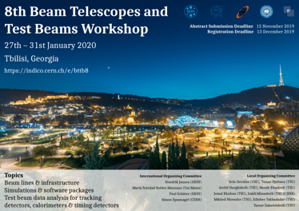Speaker
Description
In order to cope with the occupancy and radiation doses expected at the High-Luminosity LHC accelerator, the ATLAS experiment will replace its Inner Detector with an all-silicon Inner Tracker (ITk), consisting of pixel and strip subsystems. The strip subsystem will be built from modules, consisting of one n+-in-p silicon strip sensor, and one or two PCB hybrids containing the front-end electronics glued directly to the sensor. A powerboard, including an HV switch, a monitoring and control ASIC, and a DC-DC converter, is also glued to the sensor.
In the last year, several prototype ITk strip modules have been tested using beams of high energy electrons produced at the DESY II testbeam facility. Tracking was provided by EUDET telescopes, consisting of six Mimosa26 pixel planes. Tracks are reconstructed using the General Broken Lines algorithm, giving a spatial resolution of several microns. An additional pixel layer, based on either the FEI4 or Alpide technology, was used to improve the timing resolution. The modules tested are built from three sensor types: the rectangular SS and LS sensors, which will be used in the central barrel region of the detector, and the annular R0 sensor, which will be used in the forward End-Cap region. For the first time, the final production version of the readout electronics, known as ABCStar, has been used. Additionally, one LS and one R0 module have been tested after irradiation to 50% beyond the expected end-of-lifetime fluence.
The data obtained allow for thorough tests of the module performance, including charge collection, noise occupancy, detection efficiency and tracking performance. Moreover, the excellent tracking resolution allows for detailed studies of various strip sensor features. Measured data have also been compared with the outputs of Allpix2 simulations. The results give confidence that the ITk strip detector will meet the requirements of the ATLAS experiment.




